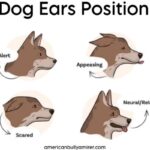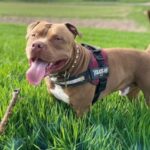Do you have any idea that the position of dogs’ ears also says something about their personality ? They indicate their feelings and emotions in different circumstances. So let’s get started and discuss some common positions of dogs’ ears along with a comprehensive dog ears position chart.
Moreover, we will also walk through some other body expressions which dogs exhibit to convey their specific emotions.

Table of Contents
Some common types of Dogs’ Ears Position Chart ears position & their meaning
According to one of the certified dog behaviourists, Dogs, wolves, jackals and some canine species use their ears as a means of communication. Chiefly these movements of ears arise from the genes of their parent dogs. Humans and other animals also influence their ways of communication through ears.
Dr. Waite has proposed 5 different ear positions of dogs and what those suggest about their moods.He helped us in understanding it well using his expertise.
1) Neutral ears’ position
The meaning of neutral ears position means a posture which a dog carries out when it feels very comfortable and relaxed in its surroundings. Some of the dog breeds like Siberian husky, German shepherd, Samoyed, Boston terriers and so forth hold pointed ears. So, they display their neutral position by leaning their ears slightly to one side.
On the other hand, Dogs with floppy ears seem to be at rest mode most of the times as their ears rarely move from their position. Hence, breeds like Dachshund, Golden Retriever and Australian shepherd keep their outer ears flopping freely with their ears’ base at ease.
2) Dropped or pinned ears’ position
The word pinned or dropped means ears of the dogs are pinned and held tight to the dog’s head.They usually pin or drop their ears when they are feeling either happy or fearful. Whenever you notice your pet in such a position, you should wait to notice their other body postures for the assurance of their emotions.
For instance, if they look slightly worried and have wrinkles on their forehead, it may be because they are feeling nervous about something. If their body is wiggly and loose, it means they are using their dropped ears to express their happiness.
3) Extremely flattened or pinned
Extremely flattened ears refers to stretching tightly ears to the one end of their head. This exhibits their fearful emotions of being harmed.
In case they feel extremely frightened, then not only but every single part of their body expresses the same. For example, their knees will bend tightly and their tails will coil between their legs.
4) Ears Changing Positions
When dogs frequently change their ear positions then, it’s a great symbol that they are trying to find out about any issue. It can be considered their expression of concern. Many times, dogs find it difficult to express their emotions or feelings specifically in any new or strange circumstances.
They are unsure about their responses.Some other body movements like closing mouths, moving their eyes here and there frequently, moving forward and backwards etc also might be visible in them. For example, when you take your dog to a chaotic street.
5) Alert & Concerned Ears
When dogs are alert and highly concerned about something, there is increased stress on the face and ears of canines. There is no need to worry in this situation as there are no aggressive or negative feelings behind their alert and concerned ears.
When your dog’s ears become more active, it means they are waiting for your instructions or commands to hear. This situation often arises when they just heard something and are trying to process the information. They prick their ears which indicates their being alert or alarmed.
Dogs’ Body language & their communicated meaning
Dogs’ body language involves a number of ways for communicating their emotions and feelings. It includes their bodily postures, eyes, tails, facial expressions etc.
As dogs depend upon non verbal communication, it’s quite different from the communication of human beings. Hence, it is also difficult for them to interpret dogs’ emotions correctly.
Let’s learn to interpret some of the body languages of dogs :
(i) Dog postures
One of the most major body language indicators is dog posture. Just like human beings, dog’s postures also tell a lot about their emotions and intentions. The following below are described different physical postures expressing various emotions of dogs :
Relaxed : All of the body parts being in a neutral position and normal breathing rate indicate their relaxation mode.
Excited : When dogs of different breeds feel excited and confident, they aren’t able to stand still and move their body rapidly. They can run, jump, roll and even bark in an excitable manner.
Playfulness : A very easy to read aspect of dogs’ body language is their playful mode. This is when either senior or puppy dogs place their chest on the ground, paws in front and keep the back end of their body part in the air.
Fear or stress : A dog moving backwards or crouch towards ground implies their state of fear or stress. In such conditions, they try to move away from something and this position makes them appear smaller than their real size. They may also hold their tails between their legs and shake.
Aggression : An aggressive trait of the dogs is usually displayed by shifting all their body weight on their front legs. Here, they try to get closer to something and display themselves larger. Their eyes are focused on their prey. The dogs can also twitch their tails sometimes when they experience any sort of conflict or feel frustrated.
(ii) Dogs’ eyes
Eyes movements of dogs are another bodily feature which denotes their distinct emotions and feelings. The following below are described some key eye movements along with their emotions being conveyed :
Winking eyes : Winking movements of eyes exhibit the dog’s excitement and playful mode.
wide & upturned eyes : It indicates that the dog is either confused or feeling nervous about something.
Narrow eyes : If they continuously keep staring on something or narrow their eyes, it shows their aggression mode.
Open & wide eyes : It also displays their playfulness and active fun mode.
Reluctant to maintain eye contact : Being polite, dogs are reluctant to maintain the eye contact. It means they are submissive towards you.
Eye contacts with few breaks : If dogs maintain eye contact with few breaks, it means they need attention of someone.
Dogs Gestures & their meanings
Gestures means the movement of any body part giving some expressions. Along with the body language, dogs also convey their emotions through their gestures. For instance, licking you or cuddling with you, both show their complete affection and trust towards you.
(i) Facial expressions
You may be thinking dogs wouldn’t be able to express them through their faces. But this is not true. They also give some facial expressions just like human beings in different situations.
Let’s try to understand some of them :
Displaying whites of eyes : If you observe the white portion (sclera) of your dog’s eye, it is often a symbol of anxiety, fear or stress. This is also known as “Whale Eye”. It happens when dogs keep their eyes fixed on one place, person or animal. So, you should try to remove the reason for their discomfort.
Open mouth or panting : Opening mouth or panting is one of most common gestures observed in dogs. It helps them to expel heat and moisture from their tongue, lungs and mouth. That’s why we mostly notice dogs panting in a hot environment.
Yawning : It refers to the wide opening of the mouth breathing in deeply. Dogs yawn mostly when they are tired or bored. Furthermore, It is also used by dogs to calm themselves when they feel stressed or over excited.
(ii) Barking
Barking of dogs is one of the most audible expressions which conveys a varied number of emotions. The tone and frequency of barking may differ depending upon the type of emotions being conveyed.
Your dog may bark out of excitement, fear or call for anything they need. Hence, it is the prime duty of its owner to observe the patterns of barking over time and learn to interpret it correctly.
(iii) Wagging Tails
Wagging Tails is always assumed as a sign of happiness and excitement. But, this is not always right. It also depends on the position of the tails while wagging. For example, tails wagging at a medium height really suggest their excitement and joy while wagging tail at high may suggest their dominance.
In the same way, the speed and distance of wagging tails also indicate something. A small wag shows their careful greeting and a broad wag implies their friendliness. Moreover, wagging their tail at high speed indicates their readiness to run or attack.
Final thoughts
Here, we came to know about different ear positions including neutral, pinned, extremely pinned and switching between positions conveying distinct feelings of dogs. Besides, how the body language of dogs, like gestures, facial expressions, barking etc , express their emotions have also been acknowledged by us.
Being a dog owner of any breed, you should closely observe all the physical features of your dog so as to understand their emotional status fully & correctly. This will help you better in fulfilling your pet’s emotional requirements.
Hope this article would have helped you in understanding different ear positions and body languages with their significance. Keep reading !
FAQs
Q1.What do the positions of dogs’ ears mean?
Ans. According to one of the certified dog behaviourists, Dogs, wolves, jackals and some canine species use their ears’ position as a means of communication.
Q2.What does extremely flattened ears indicate?
Ans. Extremely flattened ears refers to stretching tightly ears to the one end of their head. This exhibits their fearful emotions of being harmed.
Q3.What is the neutral position of a dog’s ears?
Ans.The meaning of neutral ears position means a posture which a dog carries out when it feels very comfortable and relaxed in its surroundings.
Hey there! I am Raj Saraf, a 23-year-old guy from India behind this awesome blog. Currently, I am pursuing my Master’s degree in English literature. Being a great admirer of this fascinating American bully dog breed, I did extensive and comprehensive research to my optimal level. During this, I got to know about some new and interesting facts about them, which encouraged me to go ahead. Moreover, I am fond of sharing my experiences and knowledge with you all! I hope you enjoy reading my blogs, and feel free to share any experiences or opinions about this amazing breed in the comments section below.










